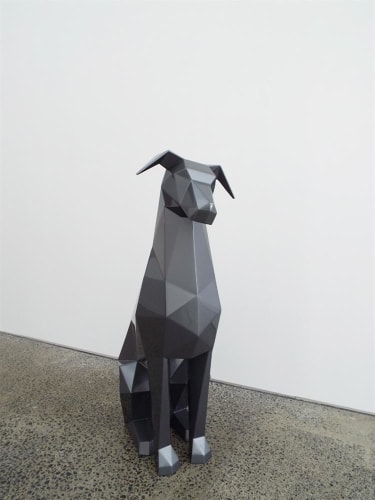"As I mused, the pale legend began to glow with life. Every line became luminous with meaning. Every shadow was suffused with light shining from behind, suggesting some mighty achievement of knowledge..." Noah Porter The Sciences of Nature Versus the Science of Man: A Plea for the Science of Man (1871)
In his latest work Ben Foster engages abstract geometric form to capture various creatures, with immaculately constructed sculptures in coated aluminium that are playful and instantly familiar. Spectrum shows works of increasing subtlety, as Foster draws contrast between light and shade, human and animal, predator and prey.
As a Minimalist, Foster is interested in reducing natural forms to their most general. His latest sculptures explore how features can be abstracted to the barest representation yet still successfully convey particular characteristics, movement and tension. Foster expertly extracts these vital details and communicates them through geometric facets, which stand in for the nuances of curve and organic shapes. Angular surfaces show a concern with the questions of shape, size and the properties of space, while the polygon structure creates unfamiliar surfaces, assuring the work retains its sculptural focus.
Foster’s animal sculptures are influenced by his strong sense of place; he is concerned with creatures that are congruent with his native environment in Kaikoura. The parallel between the sculpture and the landscape is evident in the cool geometric lines of Foster’s work that echo the craggy triangular peaks of the Seaward Ranges. Foster responds to the concerns of Environmental art, becoming part of the natural context it inhabits by altering and interacting with surroundings. Dynamic light-dependent forms change in response to the environment, augmenting and altering the viewer’s experience of the physical surroundings. New works Karearea (New Zealand’s native falcon) and The White Deer are elegant creatures captured in tense motion. The two works represent the power of the predator and the vulnerability of the prey.
Spectrum includes Foster’s first human figures, which can be viewed as self portraits of sorts. The figures stand with feet astride, weight casually balanced and hands in “pockets”; the viewer is presented with an impression of relaxed detachment that may conceal more complex emotions beneath the masklike surfaces. The titles Figure 282 and Figure 88 are based on the number of facets that complete each form – a reminder that Foster is essential concerned with aesthetics, balance and symmetry.
Previously Foster’s works have been white – casting shade rather than reflecting light. The darker tones seen in Spectrum create a new, more ambiguous mood; dark surfaces glisten and mirror light across the glossy faceted surfaces of the work.
Throughout his practice, Foster distils natural and man-made forms to an essential core, realigning manufactured structures with their natural origins while evoking the functional elegance of these utilitarian objects.
